A 245 GHz Real-Time Wideband Wireless Communication Link with 30 Gbps Data Rate
Abstract
:1. Introduction
2. System Architectures and Configurations
3. Base-Band Module with 30 Gbps Data Rate
4. IF Module Configuration
5. THz Front-End Module
6. System Measurement Results
7. Conclusions
Author Contributions
Funding
Institutional Review Board Statement
Informed Consent Statement
Data Availability Statement
Conflicts of Interest
References
- Fettweis, G.; Alamouti, S. 5G: Personal mobile internet beyond what cellular did to telephony. IEEE Commun. Mag. 2014, 52, 140–145. [Google Scholar] [CrossRef]
- Khan, L.U.; Yaqoob, I.; Imran, M.; Han, Z.; Hong, C.S. 6G wireless systems: A vision, architectural elements, and future directions. IEEE Access 2020, 8, 147029–147044. [Google Scholar] [CrossRef]
- Jiang, W.; Han, B.; Habibi, M.A.; Schotten, H.D. The road towards 6G: A comprehensive survey. IEEE Open J. Commun. Soc. 2021, 2, 334–366. [Google Scholar] [CrossRef]
- Federici, J.; Moeller, L. Review of terahertz and subterahertz wireless communications. J. Appl. Phys. 2010, 107, 6. [Google Scholar] [CrossRef]
- Kleine-Ostmann, T.; Nagatsuma, T. A review on terahertz communications research. J. Infrared Millim. Terahertz Waves 2011, 32, 143–171. [Google Scholar] [CrossRef]
- Nagatsuma, T.; Ducournau, G. Advances in terahertz communications accelerated by photonics. Nat. Photonics 2016, 10, 371–379. [Google Scholar] [CrossRef]
- Song, H.J.; Nagatsuma, T. Present and future of terahertz communications. IEEE Trans. Terahertz Sci. Technol. 2011, 1, 256–263. [Google Scholar] [CrossRef]
- Akyildiz, I.F.; Han, C.; Hu, Z.; Nie, S.; Jornet, J.M. Terahertz band communication: An old problem revisited and research directions for the next decade. IEEE Trans. Commun. 2022, 70, 4250–4285. [Google Scholar] [CrossRef]
- Koenig, S. Wireless sub-THz communication system with high data rate enabled by RF photonics and active MMIC technology. In Proceedings of the 2014 IEEE Photonics Conference, Diego, CA, USA, 12–16 October 2014; pp. 414–415. [Google Scholar]
- Kallfass, I.; Boes, F.; Messinger, T.; Antes, J.; Inam, A.; Lewark, U.; Tessmann, A.; Henneberger, R. 64 Gbit/s transmission over 850 m fixed wireless link at 240 GHz carrier frequency. J. Infrared Millim. Terahertz Waves 2015, 36, 221–233. [Google Scholar] [CrossRef]
- Hara, S.; Takano, K.; Katayama, K.; Dong, R.; Lee, S.; Watanabe, I.; Sekine, N.; Kasamatsu, A.; Yoshida, T.; Amakawa, S.; et al. 300-GHz CMOS transceiver for terahertz wireless communication. In Proceedings of the 2018 Asia-Pacific Microwave Conference (APMC), Kyoto, Japan, 6–9 November 2018; pp. 429–431. [Google Scholar]
- Koenig, S.; Lopez-Diaz, D.; Antes, J.; Boes, F.; Henneberger, R.; Leuther, A.; Tessmann, A.; Schmogrow, R.; Hillerkuss, D.; Palmer, R.; et al. Wireless sub-THz communication system with high data rate. Nat. Photonics 2013, 7, 977–981. [Google Scholar] [CrossRef]
- Hamada, H.; Tsutsumi, T.; Matsuzaki, H.; Fujimura, T.; Abdo, I.; Shirane, A.; Okada, K.; Itami, G.; Song, H.J.; Sugiyama, H.; et al. 300-GHz-band 120-Gb/s wireless front-end based on InP-HEMT PAs and mixers. IEEE J. Solid-State Circuits 2020, 55, 2316–2335. [Google Scholar] [CrossRef]
- Wu, Q.; Lin, C.; Lu, B.; Miao, L.; Hao, X.; Wang, Z.; Jiang, Y.; Lei, W.; Den, X.; Chen, H.; et al. A 21 km 5 Gbps real time wireless communication system at 0.14 THz. In Proceedings of the 2017 42nd International Conference on Infrared, Millimeter, and Terahertz Waves, Cancun, Mexico, 27 August–1 September 2017; pp. 1–2. [Google Scholar]
- Takahashi, H.; Kosugi, T. 10-Gbit/s BPSK modulator and demodulator for a 120-Ghz-band wireless link. IEEE Trans. Microw. Theory Tech. 2011, 59, 1361–1368. [Google Scholar] [CrossRef]
- Moghadami, S.; Hajilou, F. A 210 Ghz fully integrated OOK transceiver for short-range wireless chip-to- chip communication in 40 nm CMOS technology. IEEE Trans. Terahertz Sci. Technol. 2015, 5, 737–741. [Google Scholar] [CrossRef]
- Eissa, M.H.; Malignaggi, A. Wideband 240-Ghz transmitter and receiver in BICMOS technology with 25-Gbit/s data rate. IEEE J. Solid-State Circuits 2018, 53, 2532–2542. [Google Scholar] [CrossRef]
- Ntouni, G.D. Real-time experimental wireless testbed with digital beamforming at 300 GHz. In Proceedings of the 2020 European Conference on Networks and Communications (EuCNC), Dubrovnik, Croatia, 15–18 June 2020; pp. 271–275. [Google Scholar]
- Feng, Y. A 20.8-Gbps dual-carrier wireless communication link in 220-GHz band. China Commun. 2021, 18, 210–220. [Google Scholar] [CrossRef]
- Feng, Y.; Zhang, B.; Qiao, C.; Dai, B. A 220-GHz-band 31.2-Gbps dual-carrier real-time wireless link using 64-QAM modulation. In Proceedings of the 2021 14th UK-Europe-China Workshop on Millimetre-Waves and Terahertz Technologies (UCMMT), Lancaster, UK, 13–15 September 2021; pp. 1–3. [Google Scholar]
- Zhang, H.; Huang, X.J.; Guo, Y.J. A 20 Gbps digital modem for high speed wireless backhaul applications. In Proceedings of the 2017 IEEE 85th Vehicular Technology Conference (VTC Spring), Sydney, NSW, Australia, 4–7 June 2017; pp. 1–5. [Google Scholar]
- Zhang, H.; Huang, X.J.; Guo, Y.J. Low-complexity digital modem implementation for high-speed point-to-point wireless communications. In Proceedings of the 2018 18th International Symposium on Communications and Information Technologies (ISCIT), Bangkok, Thailand, 26–29 September 2018; pp. 16–21. [Google Scholar]
- Xilinx. Available online: https://www.xilinx.com/products/silicon-devices/fpga/virtex-7.html#productTable (accessed on 30 August 2022).
- Analog Devices. Available online: https://www.analog.com/en/products/ad9739.html (accessed on 30 August 2022).
- E2V. Available online: https://www.e2v.com/resources/account/download-datasheet/1735 (accessed on 30 August 2022).
- Spirent. Available online: https://www.spirent.com/assets/u/spirent_fx2_datasheet (accessed on 30 August 2022).
- Shafik, R.A.; Rahman, M.S.; Islam, A.R. On the extended relationships among EVM, BER and SNR as performance metrics. In Proceedings of the 2006 International Conference on Electrical and Computer Engineering, Dhaka, Bangladesh, 19–21 December 2006; pp. 408–411. [Google Scholar]
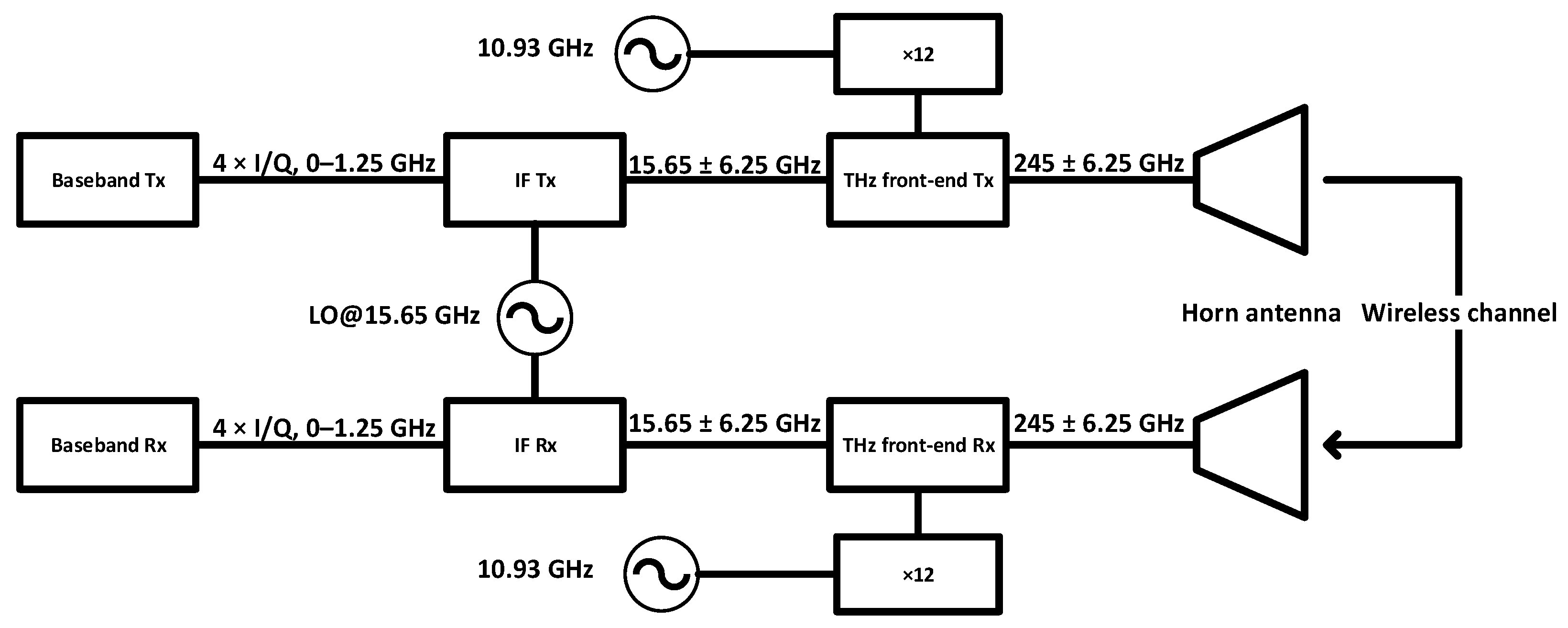
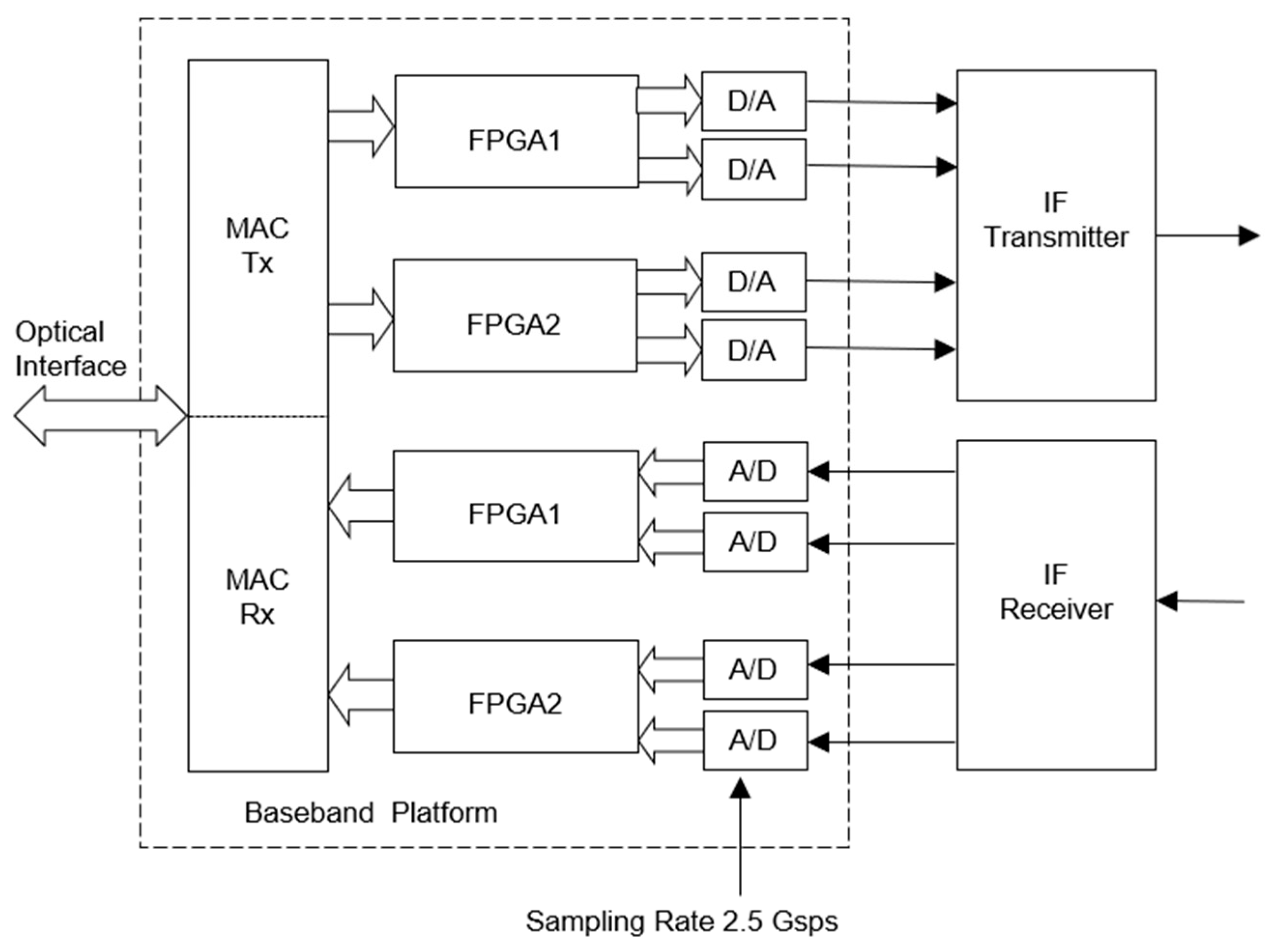

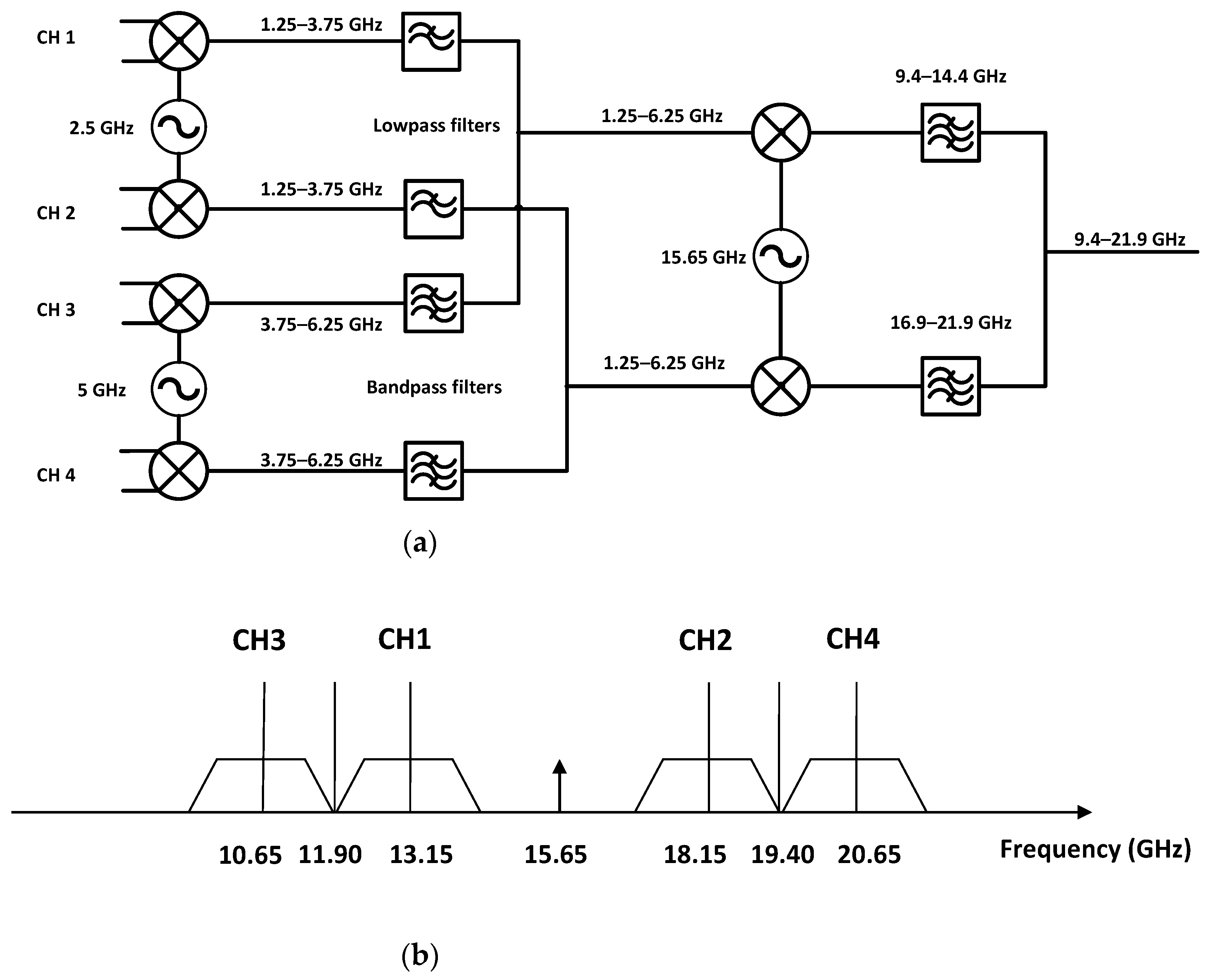



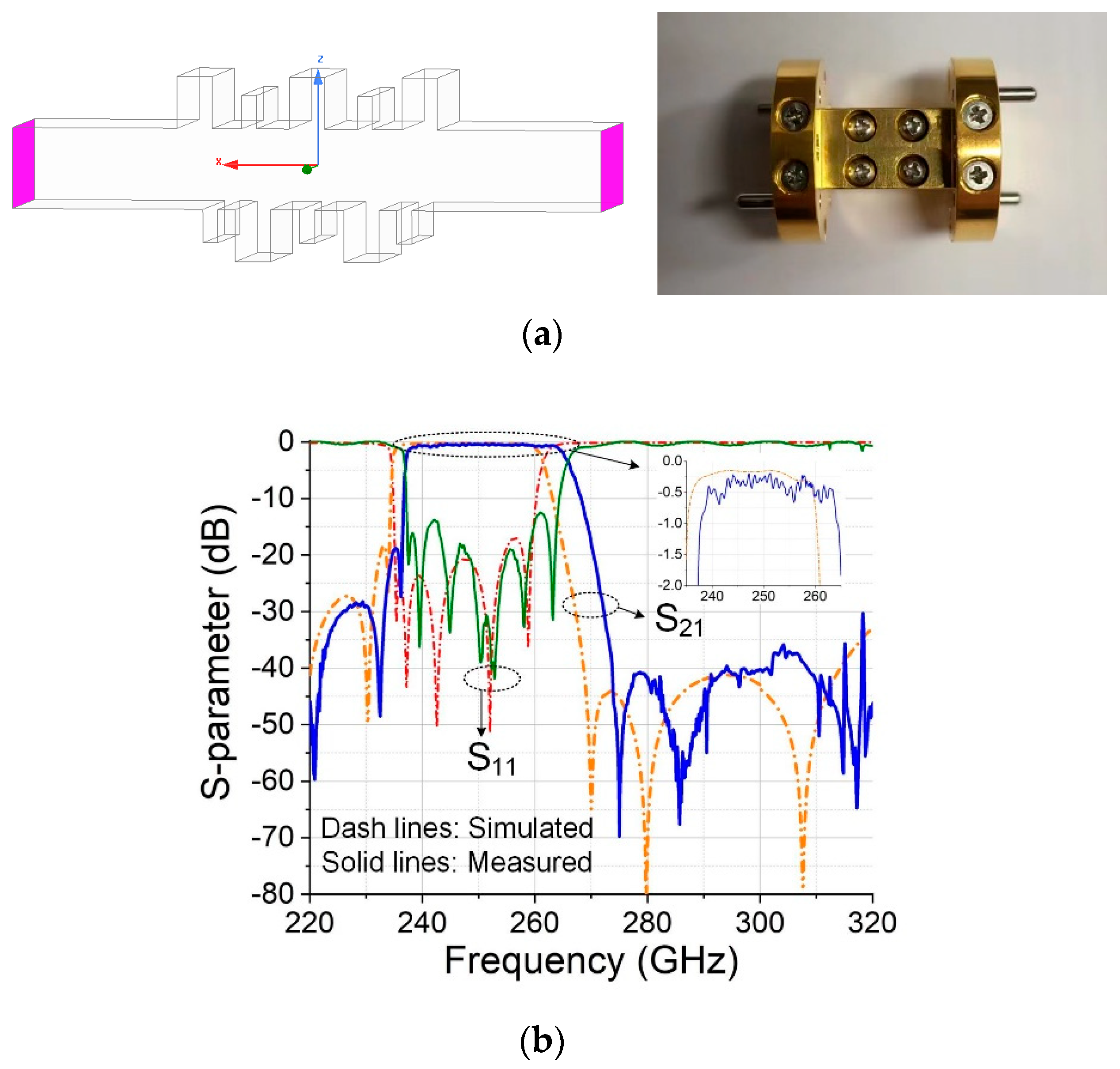

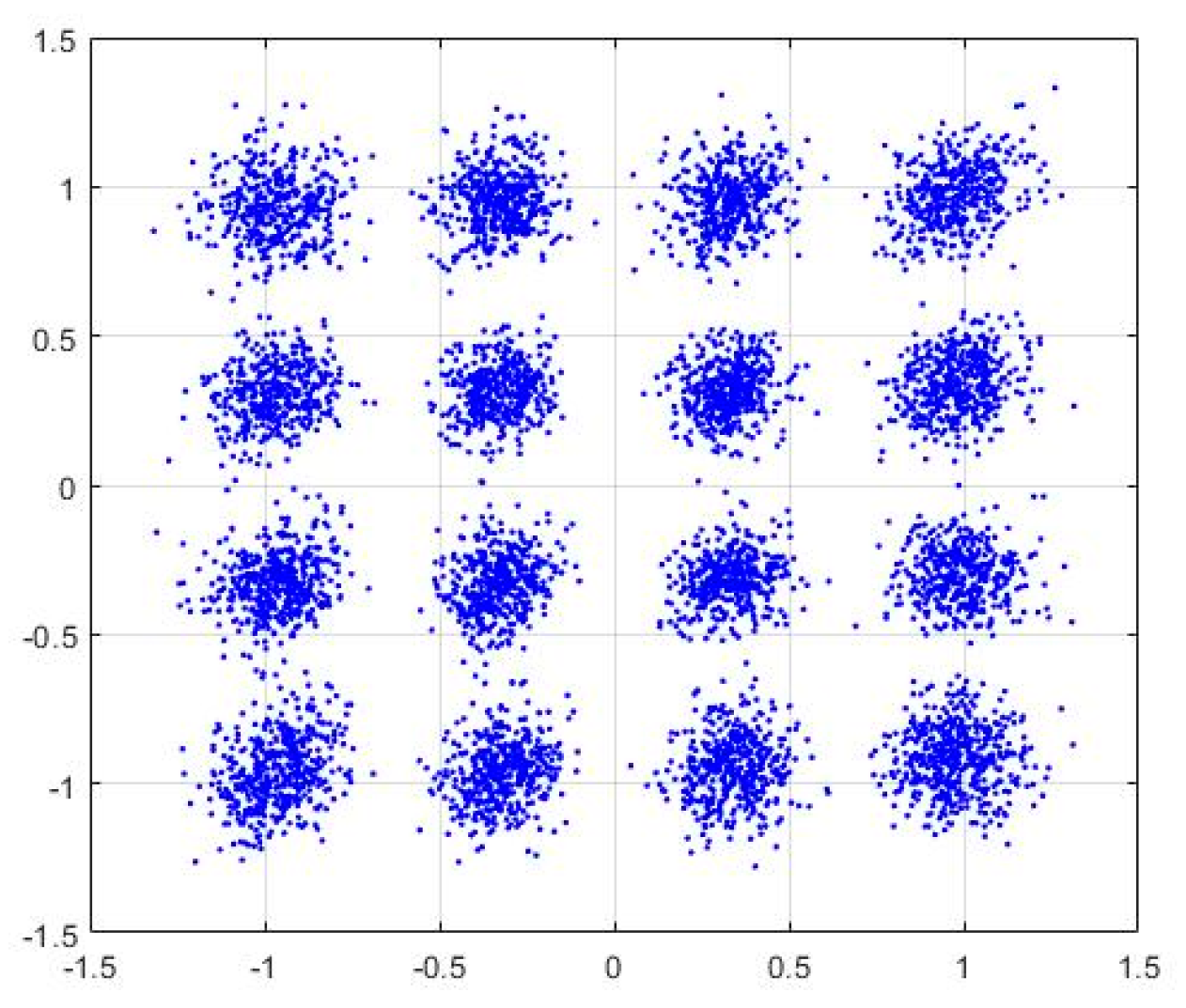
| Cell Name | Slice LUTs | Slice Registers | Block Rams | Multipliers |
|---|---|---|---|---|
| Used number | 289,095 | 425,772 | 687 | 2276 |
| Total | 433,200 | 866,400 | 1470 | 3600 |
| Usage Rate | 66.37% | 49.1% | 46.7% | 63.2% |
| Ref. | Freq (GHz) | Bandwidth (GHz) | Data Rate (Gbps) | Modulation Scheme | DAC/ADC Sampling Rate (Gsps) | Distance (m) |
|---|---|---|---|---|---|---|
| [18] | 300 | 1.5 | 3 | QPSK | 2.45 | 60 |
| [19] | 220 | 5.2 | 20.8 | 16 QAM | 6.4 | 0.3/1030 * |
| [20] | 220 | 5.2 | 31.2 | 64 QAM | 6.4 | 0.05 |
| This work | 245 | 12.5 | 30 | 16 QAM | 2.5 | 1.2 |
Publisher’s Note: MDPI stays neutral with regard to jurisdictional claims in published maps and institutional affiliations. |
© 2022 by the authors. Licensee MDPI, Basel, Switzerland. This article is an open access article distributed under the terms and conditions of the Creative Commons Attribution (CC BY) license (https://creativecommons.org/licenses/by/4.0/).
Share and Cite
Zhang, T.; Zhang, H.; Huang, X.; Suzuki, H.; Pathikulangara, J.; Smart, K.; Du, J.; Guo, J. A 245 GHz Real-Time Wideband Wireless Communication Link with 30 Gbps Data Rate. Photonics 2022, 9, 683. https://doi.org/10.3390/photonics9100683
Zhang T, Zhang H, Huang X, Suzuki H, Pathikulangara J, Smart K, Du J, Guo J. A 245 GHz Real-Time Wideband Wireless Communication Link with 30 Gbps Data Rate. Photonics. 2022; 9(10):683. https://doi.org/10.3390/photonics9100683
Chicago/Turabian StyleZhang, Ting, Hao Zhang, Xiaojing Huang, Hajime Suzuki, Joseph Pathikulangara, Ken Smart, Jia Du, and Jay Guo. 2022. "A 245 GHz Real-Time Wideband Wireless Communication Link with 30 Gbps Data Rate" Photonics 9, no. 10: 683. https://doi.org/10.3390/photonics9100683






